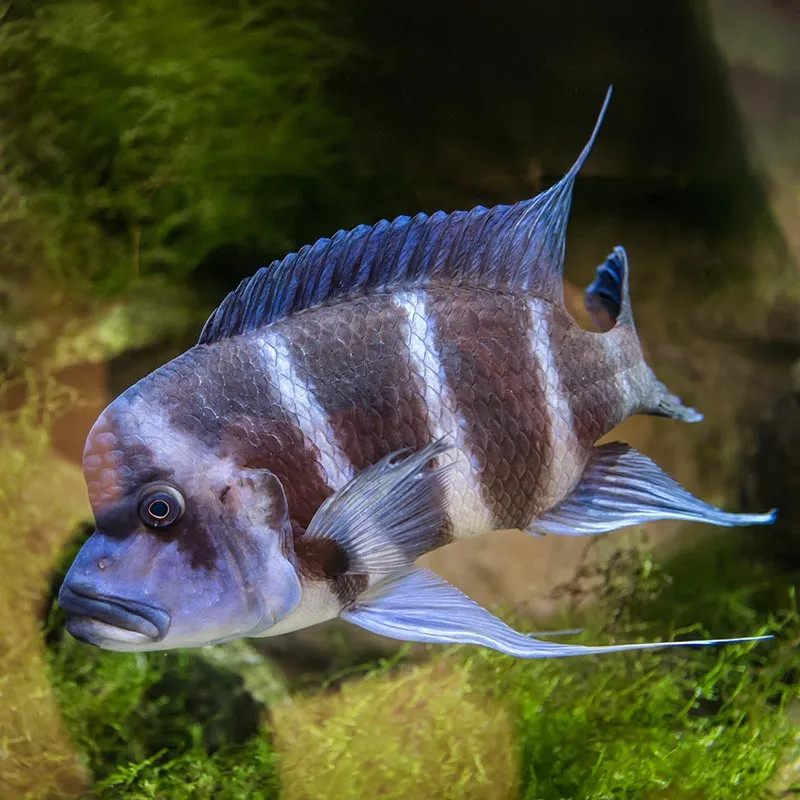Stocks Available
GREEN TERROR
SKU:118354
ANDINOACARA RIVULATUS
5 CM

Stock Available
Introduction: • Common Names: Frontosa Cichlid • Natural Habitat: Native to the rocky substrates of Lake Tanganyika in East Africa, known for its deep waters and diverse aquatic environment. Physical Characteristics: • Appearance: Characterized by a long, elongated body and prominent nuchal hump on the forehead. They exhibit a striking coloration, usually blue or gray with black spots. • Size: Can grow up to 12-15 inches (30-38 cm) in length, with some individuals reaching even larger sizes. • Lifespan: With proper care, they can live for 10-20 years, making them a long-term commitment for aquarists. Habitat Requirements: • Tank Size: A minimum of 75 gallons is recommended for a single fish or a small group, allowing ample swimming space and territories. • Water Conditions: o Temperature: Prefers temperatures between 74-80°F (23-27°C). o pH: Thrives in alkaline water, ideally between 7.8 to 9.0. • Aquascaping: Provide plenty of hiding spots using rocks and caves, as they are territorial and need areas to establish their own space. Diet: • Primary Diet: Omnivorous; in the wild, they feed on small fish, crustaceans, and plant matter. • Supplemental Feeding: In captivity, provide high-quality pellets, flakes, and occasional live or frozen foods like brine shrimp and bloodworms to ensure a balanced diet. • Feeding Frequency: Feed small portions 1-2 times a day, adjusting the amount based on their size and activity level. Compatibility: • Temperament: Generally peaceful but can be territorial, especially during breeding. Males may become aggressive towards each other. • Suitable Tank Mates: Compatible with larger, peaceful fish from the same region, such as other Tanganyikan cichlids, but avoid smaller fish that may be viewed as prey. • Incompatibilities: Avoid aggressive species that may stress or harm the Frontosa. Care Level: • Difficulty: Moderate; they require stable water conditions and adequate space to thrive. • Health Monitoring: Regularly check for signs of stress or disease, particularly in regards to water quality, as poor conditions can lead to illness. Breeding: • Breeding in Captivity: Possible with proper conditions; they form monogamous pairs and may exhibit complex courtship behaviors. • Spawning: Egg layers; females lay eggs on flat surfaces, and males guard the territory, protecting both the eggs and fry. Economic Considerations: • Market Demand: Highly sought after in the aquarium trade due to their unique appearance and personality. • Wholesale/Retail Pricing: Prices can vary based on size and coloration but generally fall within the moderate to high range. Sustainability and Conservation: • Wild Population: Stable but potentially threatened by habitat destruction and overfishing in some areas. • Aquaculture Efforts: Increasingly bred in captivity to meet demand and reduce pressure on wild populations. • Regulations: It’s important to follow CITES and local regulations to protect wild populations and their habitats. Conclusion: The Frontosa Cichlid is a stunning addition to any freshwater aquarium, known for its impressive size and beautiful coloration. With proper care and attention to their specific needs, these fish can thrive in a well-maintained environment, providing enjoyment to aquarists for many years.
Data sheet
7 other products in the same category: